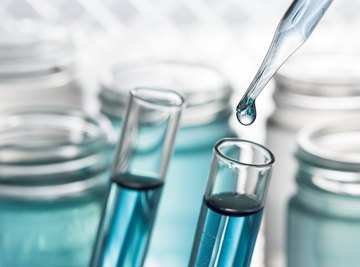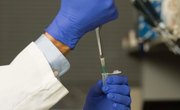
All over the world, chemical reactions are being done at this moment — in university and high-school lab experiments, in countless industrial settings and inside your own body.
One defining trait of all the reactions is that molecules combine in molar ratios, or known ratios of particles (atoms or molecules), rather than in mass ratios, although the mass ratios can be determined from given reactions from the individual molecular weights of the constituent particles.
For example, the reaction of hydrochloric acid with sodium hydroxide in solution to form table salt and water is represented by HCl + NaOH → NaCl + H2O. This tells you that there is one "piece" of acid, base, salt and water needed for this reaction to balance, as it does here. Yet the individual masses of these four molecules are quite different.
One way to standardize chemical reaction in solution is to use a process called titration, which in turn draws ultimately on compounds called primary standard substances.
What Is Titration?
Sometimes, you might be mixing volumes of two reactant solutions of known masses but only know the molar concentration of one of them. If you know when the reaction is over, you can use molar ratios to figure out the number of moles of product made, and use this plus the volume of the unknown solution to determine the molar concentration of the unknown solution.
In order for this to be useful, the concentration of the reference solution, called the titrant, must be known very precisely. If it is not, errors in this value will be propagated in your calculations to errors in the concentration of the unknown,
A primary standard solution is a solution with a highly trustworthy concentration of a particular reactant, and it is obtained from a primary standard titration of a special substance known as, you guessed it, a primary standard substance.
Characteristics of Primary Standard Substances
A primary standard compound is dissolved in pure water to create a primary solution. You can imagine how an error you could tolerate in a chem lab experiment, and would actually be a great result in this setting, would be unacceptable when truly high accuracy is demanded.
The four most important properties of a primary standard substance are described below.
A primary standard substance is pure: If impurities are present in the solid, this will throw off the calculation of the molarity of the putative standard solution and cause other problems. 99.9 purity (999 parts out of 1,000) is considered acceptable for a primary standard substance. Sodium carbonate (Na2CO3) is available at this level of purity.
A primary standard substance is plentiful and inexpensive: Many substances are cheap and easy to come by, such as NaOH (a base that could be used to titrate acids) but are difficult to difficult to keep pure. NaOH tends to absorb small amounts of water from its surroundings, and other compounds are beset by similar difficulties with their handling.
A primary standard substance has a known formula: Some substances dissolve in water to yield a mix of related compounds. For example, when nitric acid (HNO3) is dissolved in water, an unknown amount of nitrous acid (HNO2) will be present in the solution and interact with molecules in the reaction of interest, scuttling the process.
A primary standard substance is unchanged during weighing: One problem scientists have faced since the beginning of time is developing measuring systems that do not affect the quantity being measured itself. Weighing substances means subjecting them to physical contact that can affect the mass, purity and other critical characteristics of a primary standard substance and hence the solution to which it contributes.
References
About the Author
Kevin Beck holds a bachelor's degree in physics with minors in math and chemistry from the University of Vermont. Formerly with ScienceBlogs.com and the editor of "Run Strong," he has written for Runner's World, Men's Fitness, Competitor, and a variety of other publications. More about Kevin and links to his professional work can be found at www.kemibe.com.
